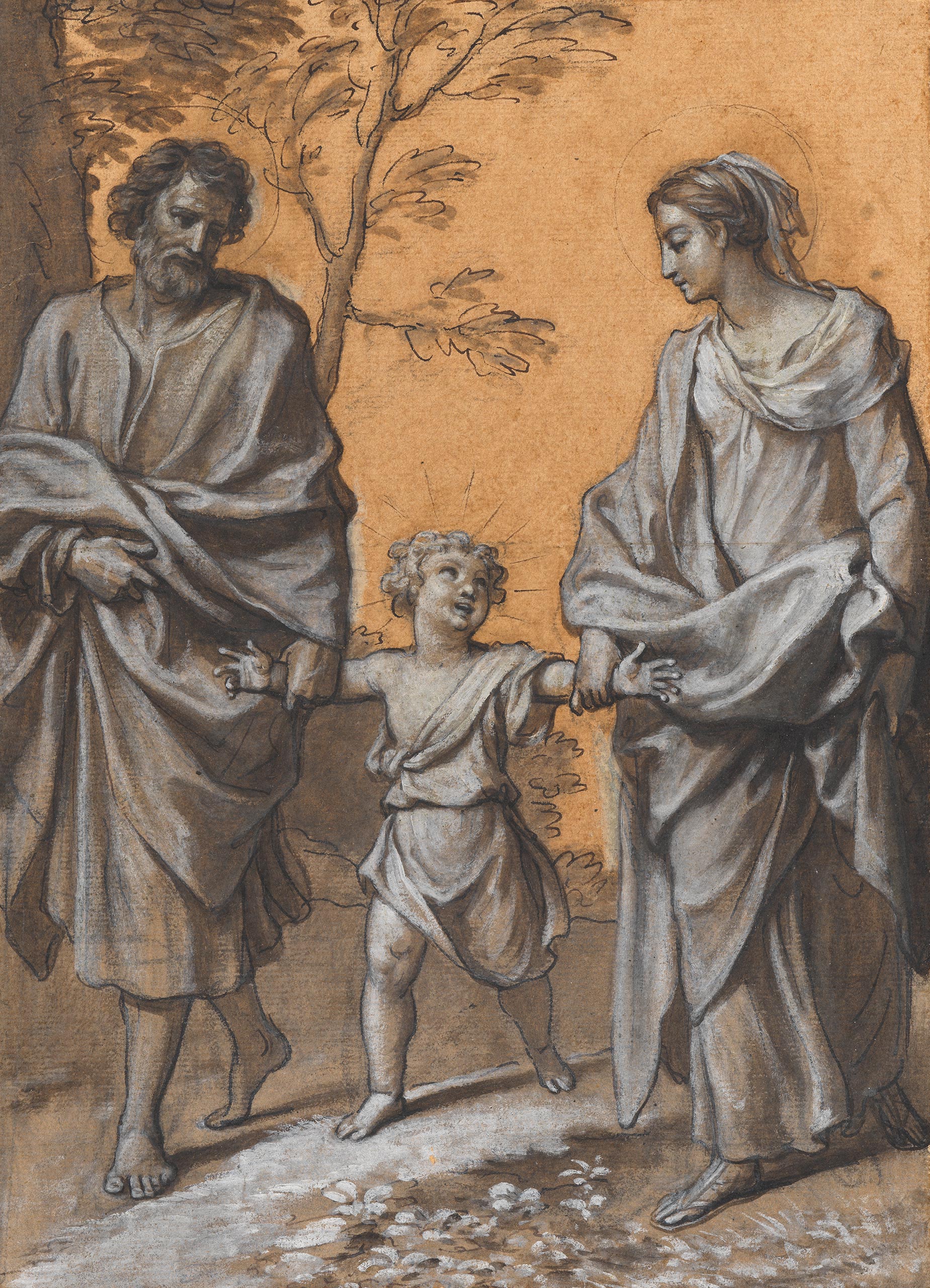
Simpol
Claude
Clamecy vers 1666 — Paris avant 1711
The Return of the Holy Family from Egypt
Plume et encre noire, gouache grise et rehauts de blanc sur papier préparé chamois.
Numéroté n° 2 au verso.
239 x 174 mm (9 7/16 x 6 13/16 in.)
Issu d’un milieu d’artisans bourguignons, Simpol se tourne vers la peinture et s’essaie, en qualité d’élève de Louis de Boullogne le jeune (1649-1717), au Grand Prix de l’Académie royale en 1683 et 1687. Le second prix obtenu ne lui permet cependant pas de partir étudier à Rome. Agréé en 1701 à l’Académie royale de peinture et de sculpture avec son esquisse pour La Dispute de Neptune et de Minerve, ou le nom à donner pour la ville d’Athènes, il ne parvient pas à terminer le morceau de réception et perd finalement son statut en mars 17091. Simpol ne reste pourtant pas inactif puisqu’il travaille à Versaille, peint trois tableaux pour la Ménagerie2 et d’autres, représentant des divertissements champêtres publiés en 2012 par François Marandet3. Toujours en 1703, les orfèvres de Paris le chargent de peindre un may pour la cathédrale, Le Christ dans la maison de Marthe et Marie (Arras,musée des Beaux-arts d’Arras). Comme Saint Roch et l’ange (Paris, Saint Nicolas des Champs), cette œuvre se caractérise par sa clarté de composition et sa palette sobre inspirées par des artistes tels qu’Eustache Le Sueur, Laurent de La Hyre et Philippe de Champaigne. François Marandet a attiré l’attention sur les liens de Simpol avec le milieu des musiciens par l’intermédiaire de son épouse, Hélène Denis, fille du facteur de clavecins et organiste Louis Denis (1635-1718) et sur son influence sur Watteau.
Simpol est aujourd’hui connu principalement pour ses dessins, dont bon nombre furent réalisés pour l’éditeur Jean Mariette, la plupart préparatoires à des gravures de dévotion, de mode ou de scènes pastorales. Ainsi ses 55 dessins dans ce que l’on appelle l’Album Elye conservé au Louvre4 ou ceux de la série des Divertissements et occupations de la campagne, qu’il réalise au début des années 1690 pour Jean Mariette et qui préparent seize gravures, attribuées à Jacques Stella jusqu’à leur publication par Jamie Mulherron5. Le Metropolitan conserve quatre dessins pour une série nommée Différents sujets, dans laquelle il dessine des figures contemporaines, musiciens, joueurs, fumeurs cavaliers etc, dans un style qui rappelle celle de son contemporain le graveur et dessinateur Picart. Bien que sa manière graphique soit différente, plus sèche et précise puisque façonnée par son métier de graveur, celui-ci a en effet aussi exécuté pour Jean Mariette plusieurs séries de gravures d’inspiration et de sujets similaires, dont les Figures de mode (1696).
Ce dessin est totalement caractéristique de Simpol, qui se reconnait par sa matière riche, un mélange de gouaches grise et blanche sur des fonds préparés d’un beige lumineux, parfois presque jaune orangé. Le sujet représenté est probablement celui du retour d’Égypte de la Sainte Famille, voyage qui a lieu dans la petite enfance du Christ. Après la mort d’Hérode, Joseph veut ramener sa famille en Judée mais devra s’installer à Nazareth en Galilée par peur du successeur d’Hérode, Arkélaüs. Cet épisode se résume à une ligne dans l’évangile selon saint Matthieu (II, 21) : « Joseph se leva, prit l’enfant et sa mère, et il entra dans le pays d’Israël ». Il pourrait également s’agir du retour du temple (Luc, II, 48-52), épisode qui succède à celui de Jésus parmi les docteurs, mais l’environnement naturel et l’aspect très enfantin de Jésus évoquent plutôt le premier sujet.
Celui-ci favorise la dévotion intime en présentant Marie et Joseph comme des parents attentionnés et Jésus comme l’enfant divin dont il leur a été donné de prendre soin. Leur expression est tendre mais sérieuse, mélancolique, comme en anticipation des souffrances à venir. Les bras étendus du Christ préfigurent en effet la croix et de la main droite, il ébauche le signe de la bénédiction, l’index et le majeur tendus, l’annulaire et l’auriculaire repliés. La beauté des personnages et leur expressivité, l’élégance du profil de la Vierge et des drapés, la finesse des émotions font de cette feuille une œuvre particulièrement touchante au sein du corpus de Simpol.
- Anatole de Montaiglon, Procès-verbaux de l’Académie royale de peinture et de sculpture, Paris, Charavay frères, 1881, tome 4, p. 78.
- G. Mabille, « Les tableaux de la Ménagerie de Versailles », Bulletin de la Société d’Histoire de l’Art Français, 1974, p. 89-101.
- François Marandet, « New Findings on the Life and Work of Claude Simpol », Metropolitan Museum Journal, 47, Metropolitan Museum of Art, New York, 2012, p. 109-118.
- Barbara Brejon de Lavergnée, Pascale Cugy, « The Album Elye in the Louvre: Claude Simpol, Matthieu Elye, Bernard Picart, and Jean Mariette », Master Drawings, vol. 51, n° 4, 2013, p. 451-470.
- Jamie Mulherron, « Claude Simpol’s Divertissemens for Jean Mariette », Print Quarterly, vol. xxv, n° 1, 2008, p. 23-36.

